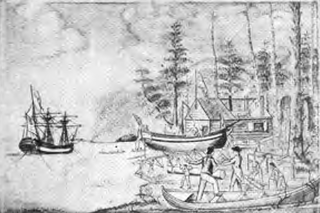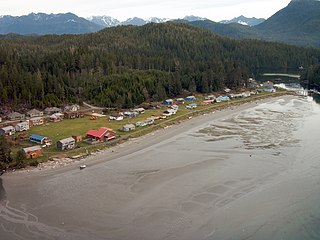
The Nuu-chah-nulth, also formerly referred to as the Nootka, Nutka, Aht, Nuuchahnulth or Tahkaht, are one of the Indigenous peoples of the Pacific Northwest Coast in Canada. The term Nuu-chah-nulth is used to describe fifteen related tribes whose traditional home is on the west coast of Vancouver Island.

The Pacific Fur Company (PFC) was an American fur trade venture wholly owned and funded by John Jacob Astor that functioned from 1810 to 1813. It was based in the Pacific Northwest, an area contested over the decades among the United Kingdom of Great Britain and Ireland, the Spanish Empire, the United States of America and the Russian Empire.

The Tla-o-qui-aht First Nations are a Nuu-chah-nulth First Nation in Canada. They live on ten reserves along the Pacific Rim National Park Reserve on Vancouver Island, British Columbia. The band is part of the Nuu-chah-nulth Tribal Council. There were 618 people living in the Tla-o-qui-aht reserves in 1995. Their primary economic activities are fishing and tourism.

Fort Astoria was the primary fur trading post of John Jacob Astor's Pacific Fur Company (PFC). A maritime contingent of PFC staff was sent on board the Tonquin, while another party traveled overland from St. Louis. This land based group later became known as the Astor Expedition. Built at the entrance of the Columbia River in 1811, Fort Astoria was the first American-owned settlement on the Pacific coast of North America.
Jonathan Thorn was a career officer of the United States Navy in the early 19th century.

Tonquin was a 290-ton American merchant ship initially operated by Fanning & Coles and later by the Pacific Fur Company (PFC), a subsidiary of the American Fur Company (AFC). Its first commander was Edmund Fanning, who sailed to the Qing Empire for valuable Chinese trade goods in 1807. The vessel was outfitted for another journey to China and then was sold to German-American entrepreneur John Jacob Astor. Included within his intricate plans to assume control over portions of the lucrative North American fur trade, the ship was intended to establish and supply trading outposts on the Pacific Northwest coast. Valuable animal furs purchased and trapped in the region would then be shipped to China, where consumer demand was high for particular pelts.

Maquinna was the chief of the Nuu-chah-nulth people of Nootka Sound, during the heyday of the maritime fur trade in the 1780s and 1790s on the Pacific Northwest Coast. The name means "possessor of pebbles". His people are today known as the Mowachaht and reside today with their kin, the Muchalaht, at Gold River, British Columbia, Canada.
Nuu-chah-nulth, a.k.a.Nootka, is a Wakashan language in the Pacific Northwest of North America on the west coast of Vancouver Island, from Barkley Sound to Quatsino Sound in British Columbia by the Nuu-chah-nulth peoples. Nuu-chah-nulth is a Southern Wakashan language related to Nitinaht and Makah.

Robert Stuart was a Scottish-born, Canadian and American fur trader, best known as a member of the first European-American party to cross South Pass during an overland expedition from Fort Astoria to Saint Louis in 1811. He was a member of the North West Company (NWC) until recruited by John Jacob Astor to develop the new Pacific Fur Company, which was based at Fort Astoria, on the coast of present-day Oregon. Astor intended the venture to develop a continent-wide commercial empire in fur trading.
The Nuu-chah-nulth Tribal Council is a First Nations Tribal Council in the Canadian province of British Columbia, located on the west coast of Vancouver Island. The organization is based in Port Alberni, British Columbia.

Fort Defiance was a small outpost that the crew of the Columbia Rediviva built as winter quarters during 1791–1792 on Meares Island in present-day British Columbia, Canada. American merchant and maritime fur trader Captain Robert Gray was in command.

Meares Island is one of the many islands surrounding the Village of Tofino, British Columbia, Canada. Its name was given in 1862 by George Henry Richards, captain of HMS Hecate, in honor of John Meares. The island is located in the Clayoquot Sound region and is the location of Opitsat, the main village of the Tla-o-qui-aht First Nations, and was the location of Fort Defiance, a short-lived American fur-trading post founded by Captain Robert Gray.
Wickaninnish was a chief of the Tla-o-qui-aht people of Clayoquot Sound, on what is now Vancouver Island, British Columbia, Canada, in the 1780s and 1790s, during the opening period of European contact with the Pacific Northwest Coast cultures. His main name is also transliterated as Wickaninish, Wickananish, Wikinanish, Huiquinanichi, and Quiquinanis, and he was also known as Hiyoua.

Opitsaht, spelled also as Opitsat and Opitsitah, is a Tla-o-qui-aht settlement/community in the Southwest area of the Meares Islands, Clayoquot South, British Columbia. This peninsula-like region is the home to the Tla-o-qui-aht people from the Nuu-chah-nulth nation, a tribe from the Pacific Northwest region in the lower Vancouver area, known for their lifestyle revolving around the marine life trade and culture within the community.
Beaver was a 427-ton merchant ship owned by John Jacob Astor that was in service from 1806 to the middle of the century.
Ovide de Montigny was a French-Canadian fur trapper active in the Pacific Northwest from 1811 to 1822.
Joseachal was a Quinault man who lived in the early 19th century. Notably he was the sole survivor of the Tonquin, a trading vessel owned by the Pacific Fur Company (PFC) that was destroyed near Vancouver Island. He was hired to act an interpreter for the vessel in negotiations with various Nuu-chah-nulth peoples. Enraged at the prices that the Tla-o-qui-aht insisted upon, captain Jonathan Thorn struck an elder with a pelt. After purchasing PFC blades, the Tla-o-qui-aht attacked and killed the crew. Only Joseachal survived to reach Fort Astoria to inform the PFC officers of the Tonquin's destruction.
François Benjamin Pillet was a French-Canadian fur trapper active in the Pacific Northwest in the early 19th century, primarily employed by the Pacific Fur Company (PFC).

Whaling on the Pacific Northwest Coast encompasses both aboriginal and commercial whaling from Washington State through British Columbia to Alaska. The indigenous peoples of the Pacific Northwest Coast have whaling traditions dating back millennia, and the hunting of cetaceans continues by Alaska Natives and to a lesser extent by the Makah people.
Margaret was an American ship built at Boston and launched in the fall of 1791. It was built for use in the maritime fur trade and was owned by Thomas Handasyd Perkins, Russell Sturgis, James and Thomas Lamb, and James Magee. It was armed with eight cannon and six to eight swivel guns. On its maiden voyage it left Boston with a crew of 25.











